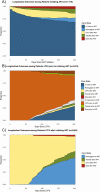Longitudinal Care Cascade Outcomes Among People Eligible for Antiretroviral Therapy Who Are Newly Linking to Care in Zambia: A Multistate Analysis
- PMID: 32173743
- PMCID: PMC7744998
- DOI: 10.1093/cid/ciaa268
Longitudinal Care Cascade Outcomes Among People Eligible for Antiretroviral Therapy Who Are Newly Linking to Care in Zambia: A Multistate Analysis
Abstract
Background: Retention in human immunodeficiency virus (HIV) care is dynamic, with patients frequently transitioning in and out of care. Analytical approaches (eg, survival analyses) commonly used to assess HIV care cascade outcomes fail to capture such transitions and therefore incompletely represent care outcomes over time.
Methods: We analyzed antiretroviral therapy (ART)-eligible adults newly linking to care at 64 clinics in Zambia between 1 April 2014 and 31 July 2015. We used electronic medical record data and supplemented these with updated care outcomes ascertained by tracing a multistage random sample of patients lost to follow-up (LTFU, >90 days late for last appointment). We performed multistate analyses, incorporating weights from sampling, to estimate the prevalence of 9 care states over time since linkage with respect to ART initiation, retention in care, transfers, and mortality.
Results: In sum, 23 227 patients (58% female; median age 34 years [interquartile range 28-41]) were ART-eligible at enrollment. At 1 year, 75.2% had initiated ART and were in care: 61.8% were continuously retained, 6.1% had reengaged after LTFU, and 7.3% had transferred. Also, 10.1% were LTFU within 7 days of enrollment, and 15.2% were LTFU at 1 year (6.7% prior to ART). One year after LTFU, 51.6% of those LTFU prior to ART remained out of care compared to 30.2% of those LTFU after initiating ART. Overall, 6.9% of patients had died by 1 year with 3.0% dying prior to ART.
Conclusion: Multistate analyses provide more complete assessments of longitudinal HIV cascade outcomes and reveal treatment gaps at distinct timepoints in care that will still need to be addressed even with universal treatment.
Keywords: HIV care cascade; Zambia; mortality; multistate analysis; retention in care.
© The Author(s) 2020. Published by Oxford University Press for the Infectious Diseases Society of America.
Figures





References
-
- UNAIDS Data 2019. UNAIDS Factsheet 2019. UNAIDS, 2019. Available at: https://www.unaids.org/sites/default/files/media_asset/UNAIDS_FactSheet_...
-
- Holmes CB, Bengtson A, Sikazwe I, et al. . Using the side door: non-linear patterns within the HIV treatment cascade in Zambia. In: Conference on Retroviruses and Opportunistic Infections. Boston, MA, March 2014.
-
- Hallett TB, Eaton JW. A side door into care cascade for HIV-infected patients? J Acquir Immune Defic Syndr 2013; 63(Suppl 2):S228–32. - PubMed
-
- Sikombe K, Kadota JL, Simbeza S, et al. . Understanding patient mobility in HIV-positive adults across multiple clinic in Zambia. In: Conference on Retroviruses and Opportunistic Infections. Boston, MA, March 2018.

